Creative Insight: Coaching Skills Training for Managers Report
VerifiedAdded on 2023/06/01
|21
|5971
|146
Report
AI Summary
This report details a coaching skills training program designed for managers at Creative Insight, an advertising company. The training aims to equip managers with the skills necessary to adapt to a changing business environment, specifically the shift towards digital media. The report begins with an executive summary and an analysis of business needs, including the company's strengths, weaknesses, opportunities, and threats, assessed using PEST and McKinsey frameworks. It outlines the training interventions, which combine action learning, informal learning, and coaching, and discusses relevant learning theories such as Adult Learning Theory, Experiential Learning Theory, and Social Learning Theory. The report also covers learning outcomes, evaluation methods, transfer of learning strategies, and a cost-benefit analysis. The goal is to enhance leadership capabilities, improve employee performance, and align individual and organizational goals, ultimately driving innovation and teamwork within Creative Insight.
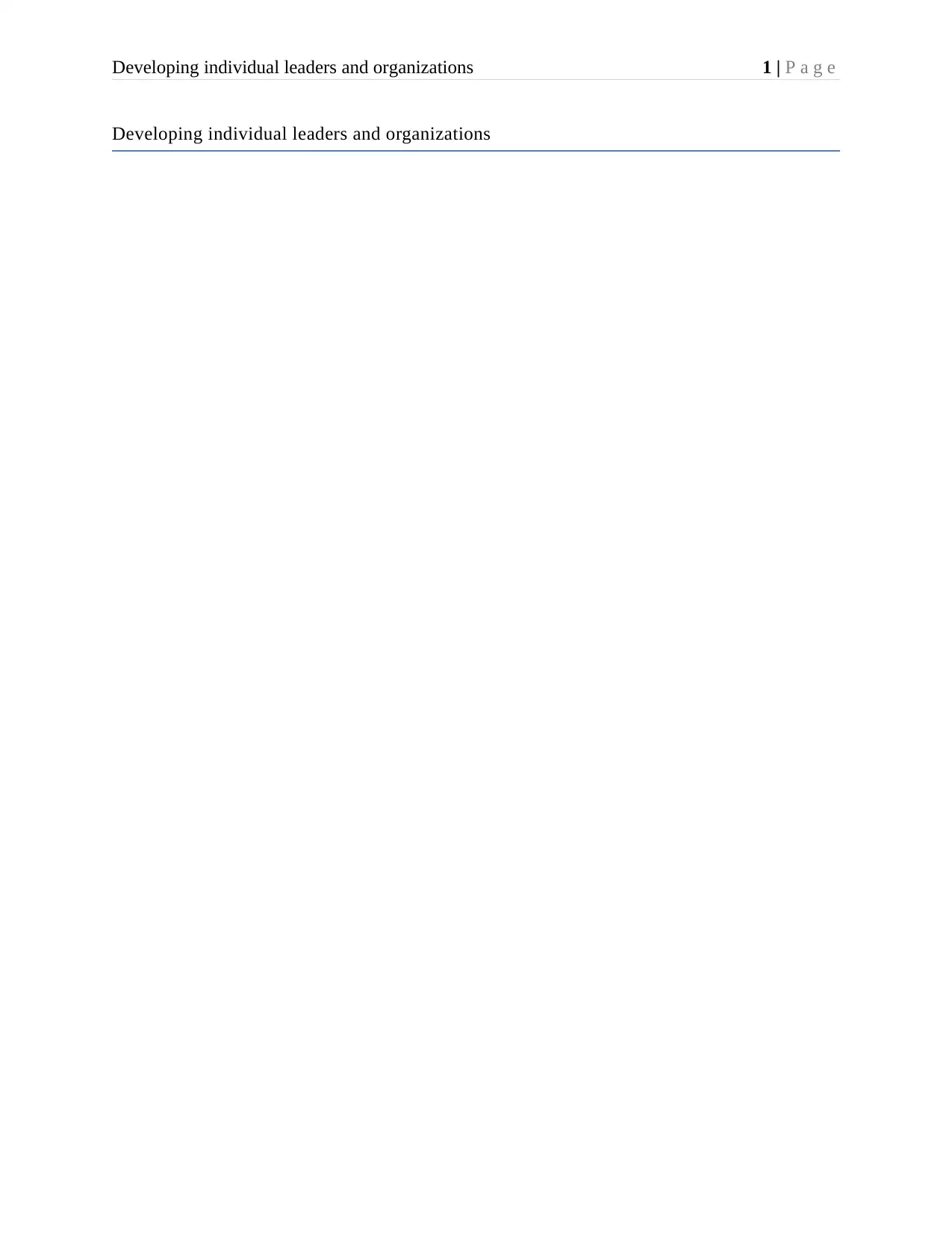
Developing individual leaders and organizations 1 | P a g e
Developing individual leaders and organizations
Developing individual leaders and organizations
Paraphrase This Document
Need a fresh take? Get an instant paraphrase of this document with our AI Paraphraser
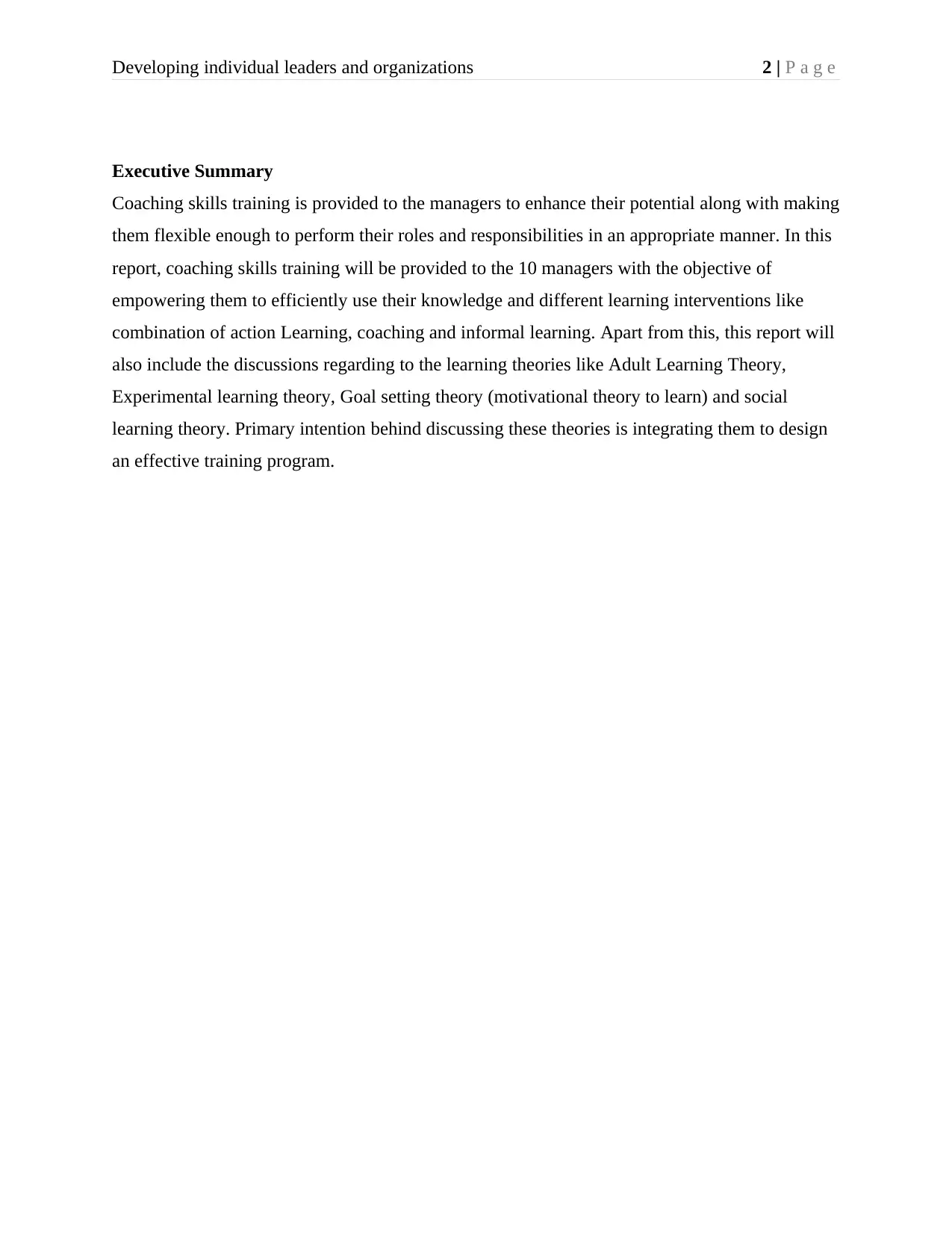
Developing individual leaders and organizations 2 | P a g e
Executive Summary
Coaching skills training is provided to the managers to enhance their potential along with making
them flexible enough to perform their roles and responsibilities in an appropriate manner. In this
report, coaching skills training will be provided to the 10 managers with the objective of
empowering them to efficiently use their knowledge and different learning interventions like
combination of action Learning, coaching and informal learning. Apart from this, this report will
also include the discussions regarding to the learning theories like Adult Learning Theory,
Experimental learning theory, Goal setting theory (motivational theory to learn) and social
learning theory. Primary intention behind discussing these theories is integrating them to design
an effective training program.
Executive Summary
Coaching skills training is provided to the managers to enhance their potential along with making
them flexible enough to perform their roles and responsibilities in an appropriate manner. In this
report, coaching skills training will be provided to the 10 managers with the objective of
empowering them to efficiently use their knowledge and different learning interventions like
combination of action Learning, coaching and informal learning. Apart from this, this report will
also include the discussions regarding to the learning theories like Adult Learning Theory,
Experimental learning theory, Goal setting theory (motivational theory to learn) and social
learning theory. Primary intention behind discussing these theories is integrating them to design
an effective training program.
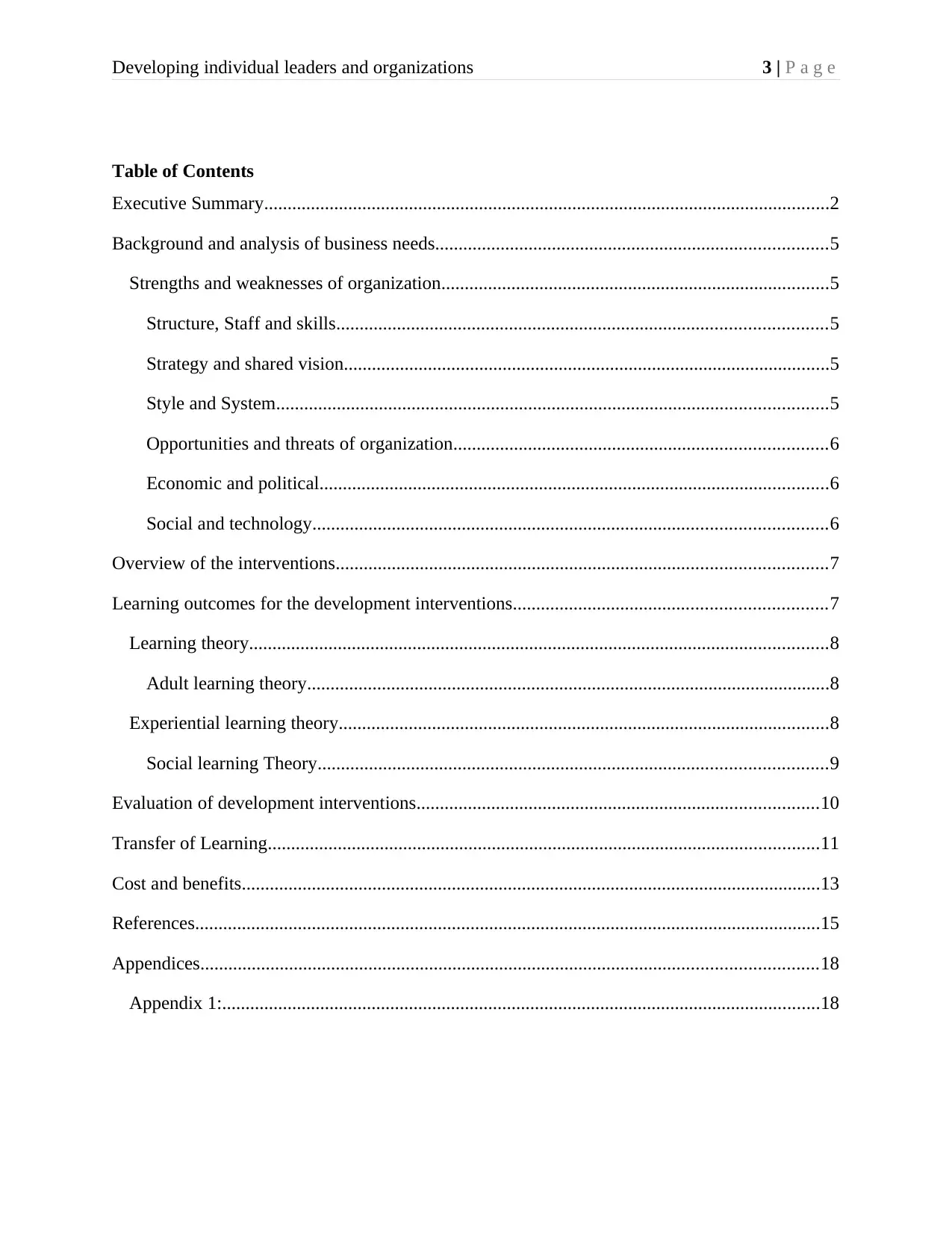
Developing individual leaders and organizations 3 | P a g e
Table of Contents
Executive Summary.........................................................................................................................2
Background and analysis of business needs....................................................................................5
Strengths and weaknesses of organization...................................................................................5
Structure, Staff and skills.........................................................................................................5
Strategy and shared vision........................................................................................................5
Style and System......................................................................................................................5
Opportunities and threats of organization................................................................................6
Economic and political.............................................................................................................6
Social and technology..............................................................................................................6
Overview of the interventions.........................................................................................................7
Learning outcomes for the development interventions...................................................................7
Learning theory............................................................................................................................8
Adult learning theory................................................................................................................8
Experiential learning theory.........................................................................................................8
Social learning Theory.............................................................................................................9
Evaluation of development interventions......................................................................................10
Transfer of Learning......................................................................................................................11
Cost and benefits............................................................................................................................13
References......................................................................................................................................15
Appendices....................................................................................................................................18
Appendix 1:................................................................................................................................18
Table of Contents
Executive Summary.........................................................................................................................2
Background and analysis of business needs....................................................................................5
Strengths and weaknesses of organization...................................................................................5
Structure, Staff and skills.........................................................................................................5
Strategy and shared vision........................................................................................................5
Style and System......................................................................................................................5
Opportunities and threats of organization................................................................................6
Economic and political.............................................................................................................6
Social and technology..............................................................................................................6
Overview of the interventions.........................................................................................................7
Learning outcomes for the development interventions...................................................................7
Learning theory............................................................................................................................8
Adult learning theory................................................................................................................8
Experiential learning theory.........................................................................................................8
Social learning Theory.............................................................................................................9
Evaluation of development interventions......................................................................................10
Transfer of Learning......................................................................................................................11
Cost and benefits............................................................................................................................13
References......................................................................................................................................15
Appendices....................................................................................................................................18
Appendix 1:................................................................................................................................18
⊘ This is a preview!⊘
Do you want full access?
Subscribe today to unlock all pages.

Trusted by 1+ million students worldwide
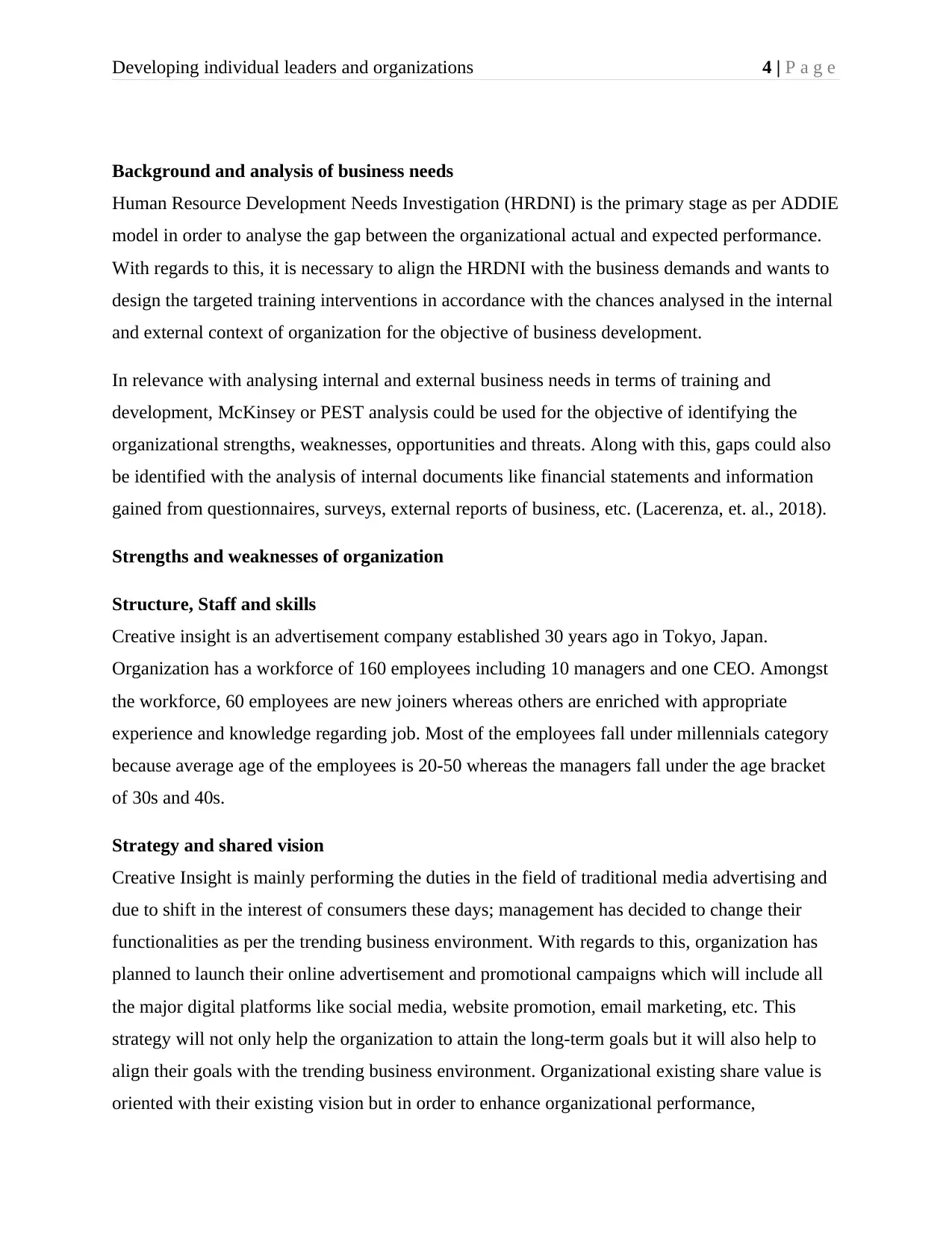
Developing individual leaders and organizations 4 | P a g e
Background and analysis of business needs
Human Resource Development Needs Investigation (HRDNI) is the primary stage as per ADDIE
model in order to analyse the gap between the organizational actual and expected performance.
With regards to this, it is necessary to align the HRDNI with the business demands and wants to
design the targeted training interventions in accordance with the chances analysed in the internal
and external context of organization for the objective of business development.
In relevance with analysing internal and external business needs in terms of training and
development, McKinsey or PEST analysis could be used for the objective of identifying the
organizational strengths, weaknesses, opportunities and threats. Along with this, gaps could also
be identified with the analysis of internal documents like financial statements and information
gained from questionnaires, surveys, external reports of business, etc. (Lacerenza, et. al., 2018).
Strengths and weaknesses of organization
Structure, Staff and skills
Creative insight is an advertisement company established 30 years ago in Tokyo, Japan.
Organization has a workforce of 160 employees including 10 managers and one CEO. Amongst
the workforce, 60 employees are new joiners whereas others are enriched with appropriate
experience and knowledge regarding job. Most of the employees fall under millennials category
because average age of the employees is 20-50 whereas the managers fall under the age bracket
of 30s and 40s.
Strategy and shared vision
Creative Insight is mainly performing the duties in the field of traditional media advertising and
due to shift in the interest of consumers these days; management has decided to change their
functionalities as per the trending business environment. With regards to this, organization has
planned to launch their online advertisement and promotional campaigns which will include all
the major digital platforms like social media, website promotion, email marketing, etc. This
strategy will not only help the organization to attain the long-term goals but it will also help to
align their goals with the trending business environment. Organizational existing share value is
oriented with their existing vision but in order to enhance organizational performance,
Background and analysis of business needs
Human Resource Development Needs Investigation (HRDNI) is the primary stage as per ADDIE
model in order to analyse the gap between the organizational actual and expected performance.
With regards to this, it is necessary to align the HRDNI with the business demands and wants to
design the targeted training interventions in accordance with the chances analysed in the internal
and external context of organization for the objective of business development.
In relevance with analysing internal and external business needs in terms of training and
development, McKinsey or PEST analysis could be used for the objective of identifying the
organizational strengths, weaknesses, opportunities and threats. Along with this, gaps could also
be identified with the analysis of internal documents like financial statements and information
gained from questionnaires, surveys, external reports of business, etc. (Lacerenza, et. al., 2018).
Strengths and weaknesses of organization
Structure, Staff and skills
Creative insight is an advertisement company established 30 years ago in Tokyo, Japan.
Organization has a workforce of 160 employees including 10 managers and one CEO. Amongst
the workforce, 60 employees are new joiners whereas others are enriched with appropriate
experience and knowledge regarding job. Most of the employees fall under millennials category
because average age of the employees is 20-50 whereas the managers fall under the age bracket
of 30s and 40s.
Strategy and shared vision
Creative Insight is mainly performing the duties in the field of traditional media advertising and
due to shift in the interest of consumers these days; management has decided to change their
functionalities as per the trending business environment. With regards to this, organization has
planned to launch their online advertisement and promotional campaigns which will include all
the major digital platforms like social media, website promotion, email marketing, etc. This
strategy will not only help the organization to attain the long-term goals but it will also help to
align their goals with the trending business environment. Organizational existing share value is
oriented with their existing vision but in order to enhance organizational performance,
Paraphrase This Document
Need a fresh take? Get an instant paraphrase of this document with our AI Paraphraser
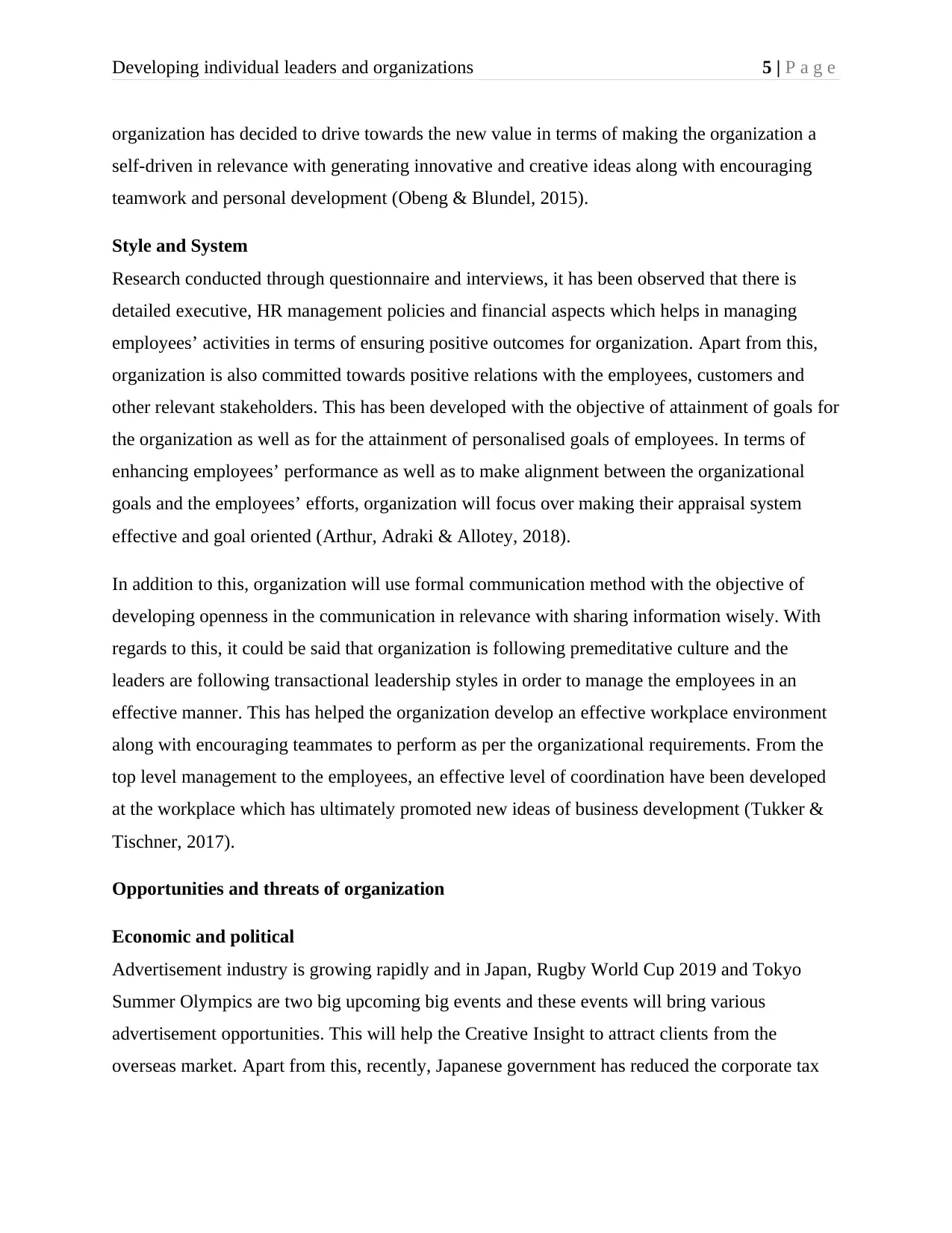
Developing individual leaders and organizations 5 | P a g e
organization has decided to drive towards the new value in terms of making the organization a
self-driven in relevance with generating innovative and creative ideas along with encouraging
teamwork and personal development (Obeng & Blundel, 2015).
Style and System
Research conducted through questionnaire and interviews, it has been observed that there is
detailed executive, HR management policies and financial aspects which helps in managing
employees’ activities in terms of ensuring positive outcomes for organization. Apart from this,
organization is also committed towards positive relations with the employees, customers and
other relevant stakeholders. This has been developed with the objective of attainment of goals for
the organization as well as for the attainment of personalised goals of employees. In terms of
enhancing employees’ performance as well as to make alignment between the organizational
goals and the employees’ efforts, organization will focus over making their appraisal system
effective and goal oriented (Arthur, Adraki & Allotey, 2018).
In addition to this, organization will use formal communication method with the objective of
developing openness in the communication in relevance with sharing information wisely. With
regards to this, it could be said that organization is following premeditative culture and the
leaders are following transactional leadership styles in order to manage the employees in an
effective manner. This has helped the organization develop an effective workplace environment
along with encouraging teammates to perform as per the organizational requirements. From the
top level management to the employees, an effective level of coordination have been developed
at the workplace which has ultimately promoted new ideas of business development (Tukker &
Tischner, 2017).
Opportunities and threats of organization
Economic and political
Advertisement industry is growing rapidly and in Japan, Rugby World Cup 2019 and Tokyo
Summer Olympics are two big upcoming big events and these events will bring various
advertisement opportunities. This will help the Creative Insight to attract clients from the
overseas market. Apart from this, recently, Japanese government has reduced the corporate tax
organization has decided to drive towards the new value in terms of making the organization a
self-driven in relevance with generating innovative and creative ideas along with encouraging
teamwork and personal development (Obeng & Blundel, 2015).
Style and System
Research conducted through questionnaire and interviews, it has been observed that there is
detailed executive, HR management policies and financial aspects which helps in managing
employees’ activities in terms of ensuring positive outcomes for organization. Apart from this,
organization is also committed towards positive relations with the employees, customers and
other relevant stakeholders. This has been developed with the objective of attainment of goals for
the organization as well as for the attainment of personalised goals of employees. In terms of
enhancing employees’ performance as well as to make alignment between the organizational
goals and the employees’ efforts, organization will focus over making their appraisal system
effective and goal oriented (Arthur, Adraki & Allotey, 2018).
In addition to this, organization will use formal communication method with the objective of
developing openness in the communication in relevance with sharing information wisely. With
regards to this, it could be said that organization is following premeditative culture and the
leaders are following transactional leadership styles in order to manage the employees in an
effective manner. This has helped the organization develop an effective workplace environment
along with encouraging teammates to perform as per the organizational requirements. From the
top level management to the employees, an effective level of coordination have been developed
at the workplace which has ultimately promoted new ideas of business development (Tukker &
Tischner, 2017).
Opportunities and threats of organization
Economic and political
Advertisement industry is growing rapidly and in Japan, Rugby World Cup 2019 and Tokyo
Summer Olympics are two big upcoming big events and these events will bring various
advertisement opportunities. This will help the Creative Insight to attract clients from the
overseas market. Apart from this, recently, Japanese government has reduced the corporate tax
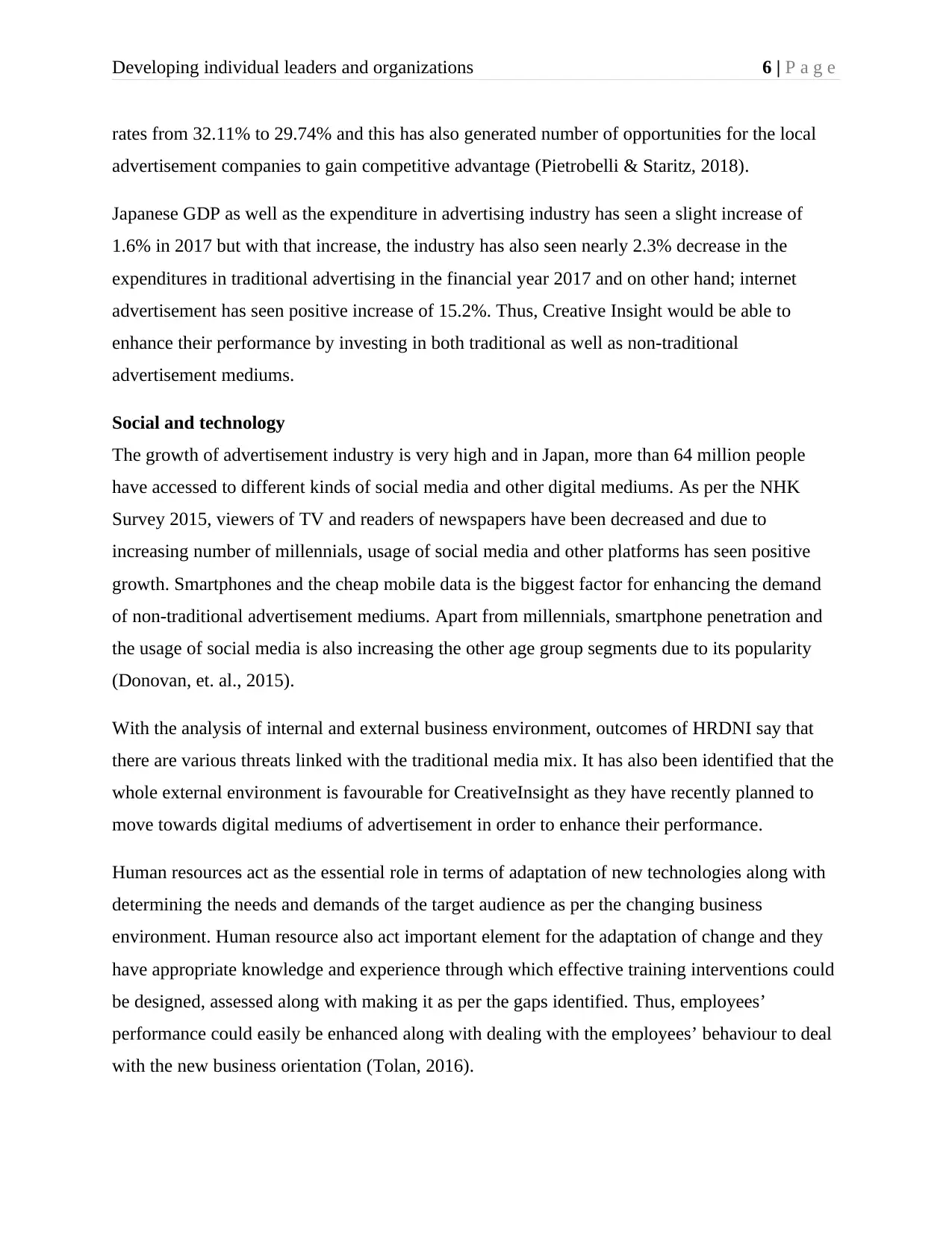
Developing individual leaders and organizations 6 | P a g e
rates from 32.11% to 29.74% and this has also generated number of opportunities for the local
advertisement companies to gain competitive advantage (Pietrobelli & Staritz, 2018).
Japanese GDP as well as the expenditure in advertising industry has seen a slight increase of
1.6% in 2017 but with that increase, the industry has also seen nearly 2.3% decrease in the
expenditures in traditional advertising in the financial year 2017 and on other hand; internet
advertisement has seen positive increase of 15.2%. Thus, Creative Insight would be able to
enhance their performance by investing in both traditional as well as non-traditional
advertisement mediums.
Social and technology
The growth of advertisement industry is very high and in Japan, more than 64 million people
have accessed to different kinds of social media and other digital mediums. As per the NHK
Survey 2015, viewers of TV and readers of newspapers have been decreased and due to
increasing number of millennials, usage of social media and other platforms has seen positive
growth. Smartphones and the cheap mobile data is the biggest factor for enhancing the demand
of non-traditional advertisement mediums. Apart from millennials, smartphone penetration and
the usage of social media is also increasing the other age group segments due to its popularity
(Donovan, et. al., 2015).
With the analysis of internal and external business environment, outcomes of HRDNI say that
there are various threats linked with the traditional media mix. It has also been identified that the
whole external environment is favourable for CreativeInsight as they have recently planned to
move towards digital mediums of advertisement in order to enhance their performance.
Human resources act as the essential role in terms of adaptation of new technologies along with
determining the needs and demands of the target audience as per the changing business
environment. Human resource also act important element for the adaptation of change and they
have appropriate knowledge and experience through which effective training interventions could
be designed, assessed along with making it as per the gaps identified. Thus, employees’
performance could easily be enhanced along with dealing with the employees’ behaviour to deal
with the new business orientation (Tolan, 2016).
rates from 32.11% to 29.74% and this has also generated number of opportunities for the local
advertisement companies to gain competitive advantage (Pietrobelli & Staritz, 2018).
Japanese GDP as well as the expenditure in advertising industry has seen a slight increase of
1.6% in 2017 but with that increase, the industry has also seen nearly 2.3% decrease in the
expenditures in traditional advertising in the financial year 2017 and on other hand; internet
advertisement has seen positive increase of 15.2%. Thus, Creative Insight would be able to
enhance their performance by investing in both traditional as well as non-traditional
advertisement mediums.
Social and technology
The growth of advertisement industry is very high and in Japan, more than 64 million people
have accessed to different kinds of social media and other digital mediums. As per the NHK
Survey 2015, viewers of TV and readers of newspapers have been decreased and due to
increasing number of millennials, usage of social media and other platforms has seen positive
growth. Smartphones and the cheap mobile data is the biggest factor for enhancing the demand
of non-traditional advertisement mediums. Apart from millennials, smartphone penetration and
the usage of social media is also increasing the other age group segments due to its popularity
(Donovan, et. al., 2015).
With the analysis of internal and external business environment, outcomes of HRDNI say that
there are various threats linked with the traditional media mix. It has also been identified that the
whole external environment is favourable for CreativeInsight as they have recently planned to
move towards digital mediums of advertisement in order to enhance their performance.
Human resources act as the essential role in terms of adaptation of new technologies along with
determining the needs and demands of the target audience as per the changing business
environment. Human resource also act important element for the adaptation of change and they
have appropriate knowledge and experience through which effective training interventions could
be designed, assessed along with making it as per the gaps identified. Thus, employees’
performance could easily be enhanced along with dealing with the employees’ behaviour to deal
with the new business orientation (Tolan, 2016).
⊘ This is a preview!⊘
Do you want full access?
Subscribe today to unlock all pages.

Trusted by 1+ million students worldwide
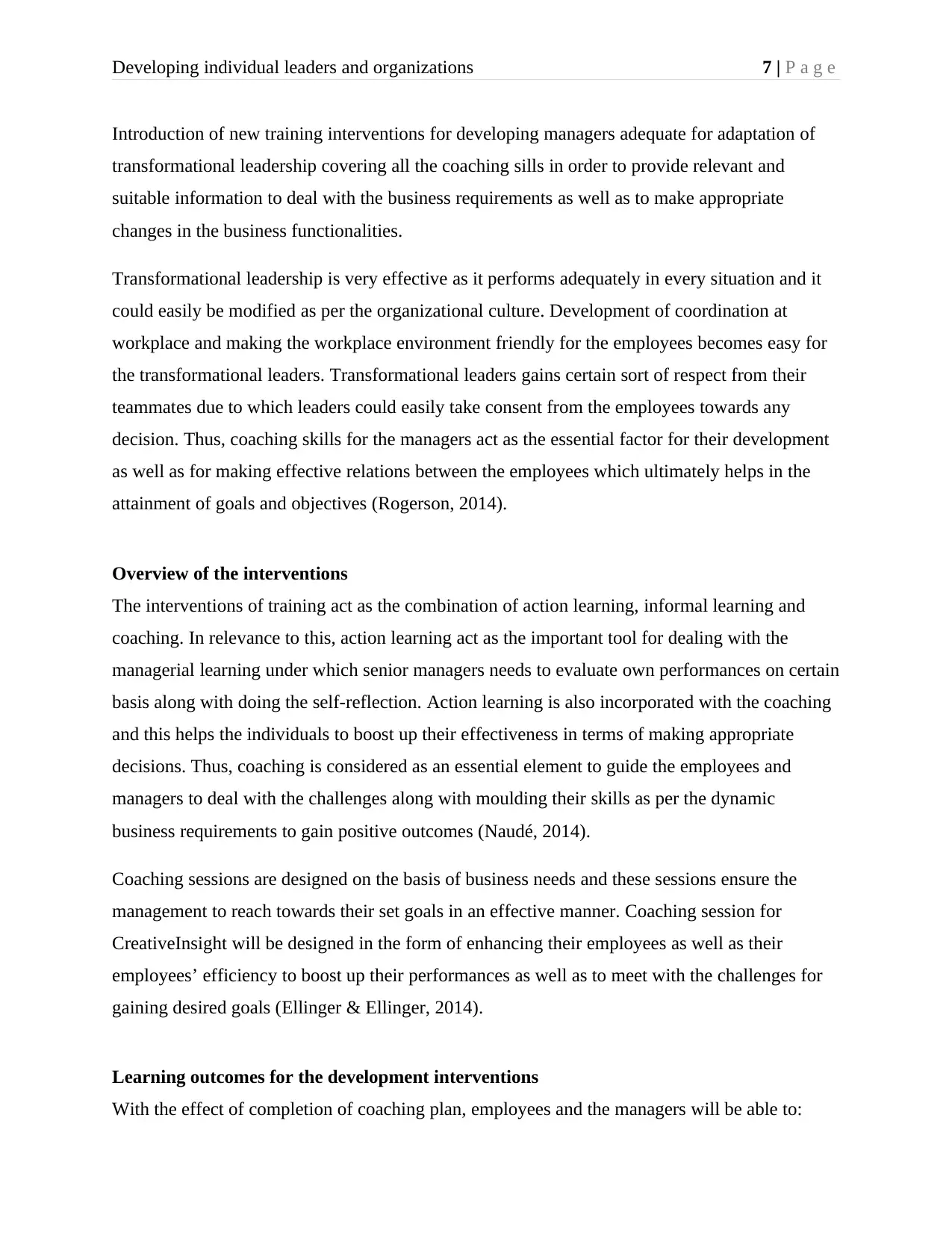
Developing individual leaders and organizations 7 | P a g e
Introduction of new training interventions for developing managers adequate for adaptation of
transformational leadership covering all the coaching sills in order to provide relevant and
suitable information to deal with the business requirements as well as to make appropriate
changes in the business functionalities.
Transformational leadership is very effective as it performs adequately in every situation and it
could easily be modified as per the organizational culture. Development of coordination at
workplace and making the workplace environment friendly for the employees becomes easy for
the transformational leaders. Transformational leaders gains certain sort of respect from their
teammates due to which leaders could easily take consent from the employees towards any
decision. Thus, coaching skills for the managers act as the essential factor for their development
as well as for making effective relations between the employees which ultimately helps in the
attainment of goals and objectives (Rogerson, 2014).
Overview of the interventions
The interventions of training act as the combination of action learning, informal learning and
coaching. In relevance to this, action learning act as the important tool for dealing with the
managerial learning under which senior managers needs to evaluate own performances on certain
basis along with doing the self-reflection. Action learning is also incorporated with the coaching
and this helps the individuals to boost up their effectiveness in terms of making appropriate
decisions. Thus, coaching is considered as an essential element to guide the employees and
managers to deal with the challenges along with moulding their skills as per the dynamic
business requirements to gain positive outcomes (Naudé, 2014).
Coaching sessions are designed on the basis of business needs and these sessions ensure the
management to reach towards their set goals in an effective manner. Coaching session for
CreativeInsight will be designed in the form of enhancing their employees as well as their
employees’ efficiency to boost up their performances as well as to meet with the challenges for
gaining desired goals (Ellinger & Ellinger, 2014).
Learning outcomes for the development interventions
With the effect of completion of coaching plan, employees and the managers will be able to:
Introduction of new training interventions for developing managers adequate for adaptation of
transformational leadership covering all the coaching sills in order to provide relevant and
suitable information to deal with the business requirements as well as to make appropriate
changes in the business functionalities.
Transformational leadership is very effective as it performs adequately in every situation and it
could easily be modified as per the organizational culture. Development of coordination at
workplace and making the workplace environment friendly for the employees becomes easy for
the transformational leaders. Transformational leaders gains certain sort of respect from their
teammates due to which leaders could easily take consent from the employees towards any
decision. Thus, coaching skills for the managers act as the essential factor for their development
as well as for making effective relations between the employees which ultimately helps in the
attainment of goals and objectives (Rogerson, 2014).
Overview of the interventions
The interventions of training act as the combination of action learning, informal learning and
coaching. In relevance to this, action learning act as the important tool for dealing with the
managerial learning under which senior managers needs to evaluate own performances on certain
basis along with doing the self-reflection. Action learning is also incorporated with the coaching
and this helps the individuals to boost up their effectiveness in terms of making appropriate
decisions. Thus, coaching is considered as an essential element to guide the employees and
managers to deal with the challenges along with moulding their skills as per the dynamic
business requirements to gain positive outcomes (Naudé, 2014).
Coaching sessions are designed on the basis of business needs and these sessions ensure the
management to reach towards their set goals in an effective manner. Coaching session for
CreativeInsight will be designed in the form of enhancing their employees as well as their
employees’ efficiency to boost up their performances as well as to meet with the challenges for
gaining desired goals (Ellinger & Ellinger, 2014).
Learning outcomes for the development interventions
With the effect of completion of coaching plan, employees and the managers will be able to:
Paraphrase This Document
Need a fresh take? Get an instant paraphrase of this document with our AI Paraphraser
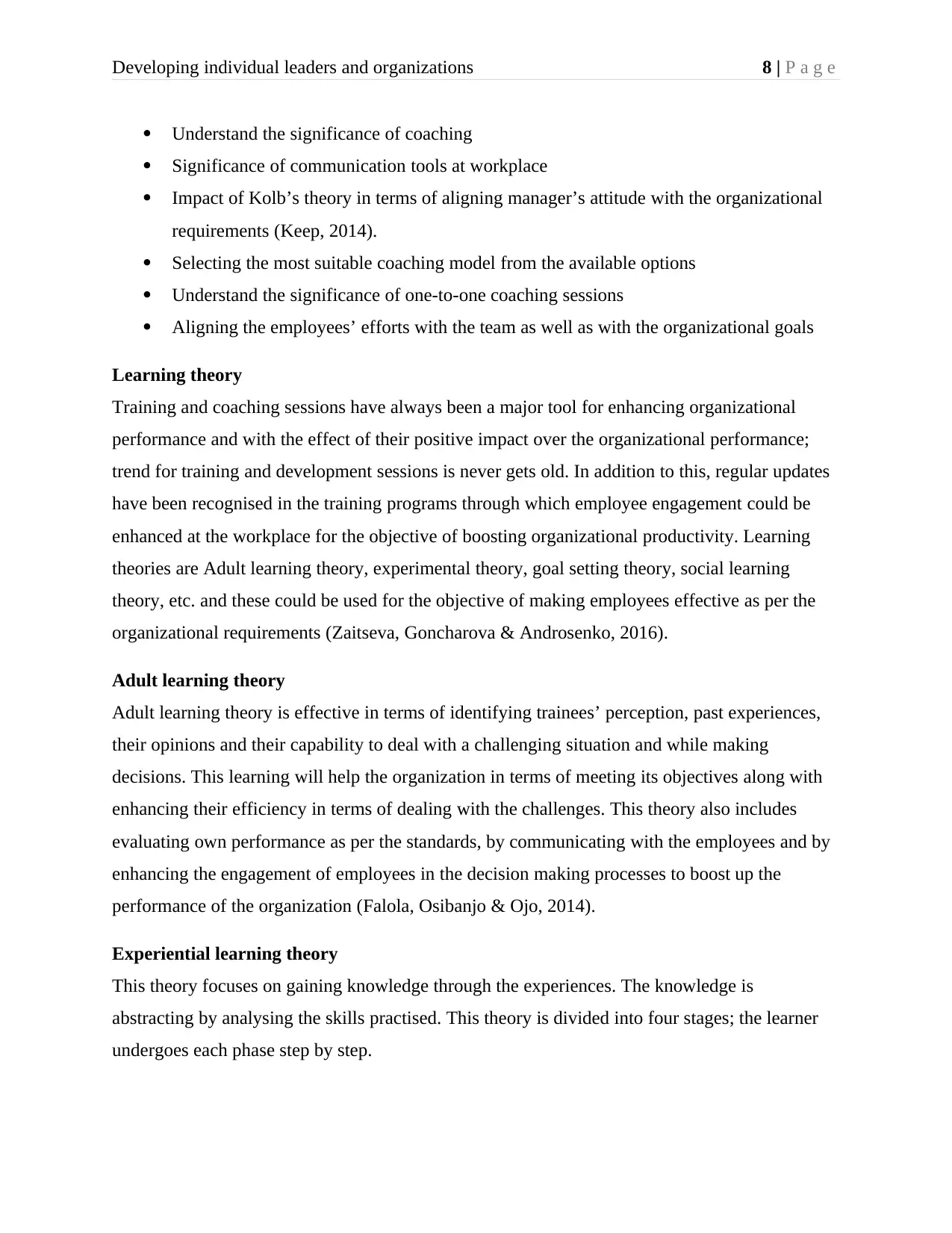
Developing individual leaders and organizations 8 | P a g e
Understand the significance of coaching
Significance of communication tools at workplace
Impact of Kolb’s theory in terms of aligning manager’s attitude with the organizational
requirements (Keep, 2014).
Selecting the most suitable coaching model from the available options
Understand the significance of one-to-one coaching sessions
Aligning the employees’ efforts with the team as well as with the organizational goals
Learning theory
Training and coaching sessions have always been a major tool for enhancing organizational
performance and with the effect of their positive impact over the organizational performance;
trend for training and development sessions is never gets old. In addition to this, regular updates
have been recognised in the training programs through which employee engagement could be
enhanced at the workplace for the objective of boosting organizational productivity. Learning
theories are Adult learning theory, experimental theory, goal setting theory, social learning
theory, etc. and these could be used for the objective of making employees effective as per the
organizational requirements (Zaitseva, Goncharova & Androsenko, 2016).
Adult learning theory
Adult learning theory is effective in terms of identifying trainees’ perception, past experiences,
their opinions and their capability to deal with a challenging situation and while making
decisions. This learning will help the organization in terms of meeting its objectives along with
enhancing their efficiency in terms of dealing with the challenges. This theory also includes
evaluating own performance as per the standards, by communicating with the employees and by
enhancing the engagement of employees in the decision making processes to boost up the
performance of the organization (Falola, Osibanjo & Ojo, 2014).
Experiential learning theory
This theory focuses on gaining knowledge through the experiences. The knowledge is
abstracting by analysing the skills practised. This theory is divided into four stages; the learner
undergoes each phase step by step.
Understand the significance of coaching
Significance of communication tools at workplace
Impact of Kolb’s theory in terms of aligning manager’s attitude with the organizational
requirements (Keep, 2014).
Selecting the most suitable coaching model from the available options
Understand the significance of one-to-one coaching sessions
Aligning the employees’ efforts with the team as well as with the organizational goals
Learning theory
Training and coaching sessions have always been a major tool for enhancing organizational
performance and with the effect of their positive impact over the organizational performance;
trend for training and development sessions is never gets old. In addition to this, regular updates
have been recognised in the training programs through which employee engagement could be
enhanced at the workplace for the objective of boosting organizational productivity. Learning
theories are Adult learning theory, experimental theory, goal setting theory, social learning
theory, etc. and these could be used for the objective of making employees effective as per the
organizational requirements (Zaitseva, Goncharova & Androsenko, 2016).
Adult learning theory
Adult learning theory is effective in terms of identifying trainees’ perception, past experiences,
their opinions and their capability to deal with a challenging situation and while making
decisions. This learning will help the organization in terms of meeting its objectives along with
enhancing their efficiency in terms of dealing with the challenges. This theory also includes
evaluating own performance as per the standards, by communicating with the employees and by
enhancing the engagement of employees in the decision making processes to boost up the
performance of the organization (Falola, Osibanjo & Ojo, 2014).
Experiential learning theory
This theory focuses on gaining knowledge through the experiences. The knowledge is
abstracting by analysing the skills practised. This theory is divided into four stages; the learner
undergoes each phase step by step.
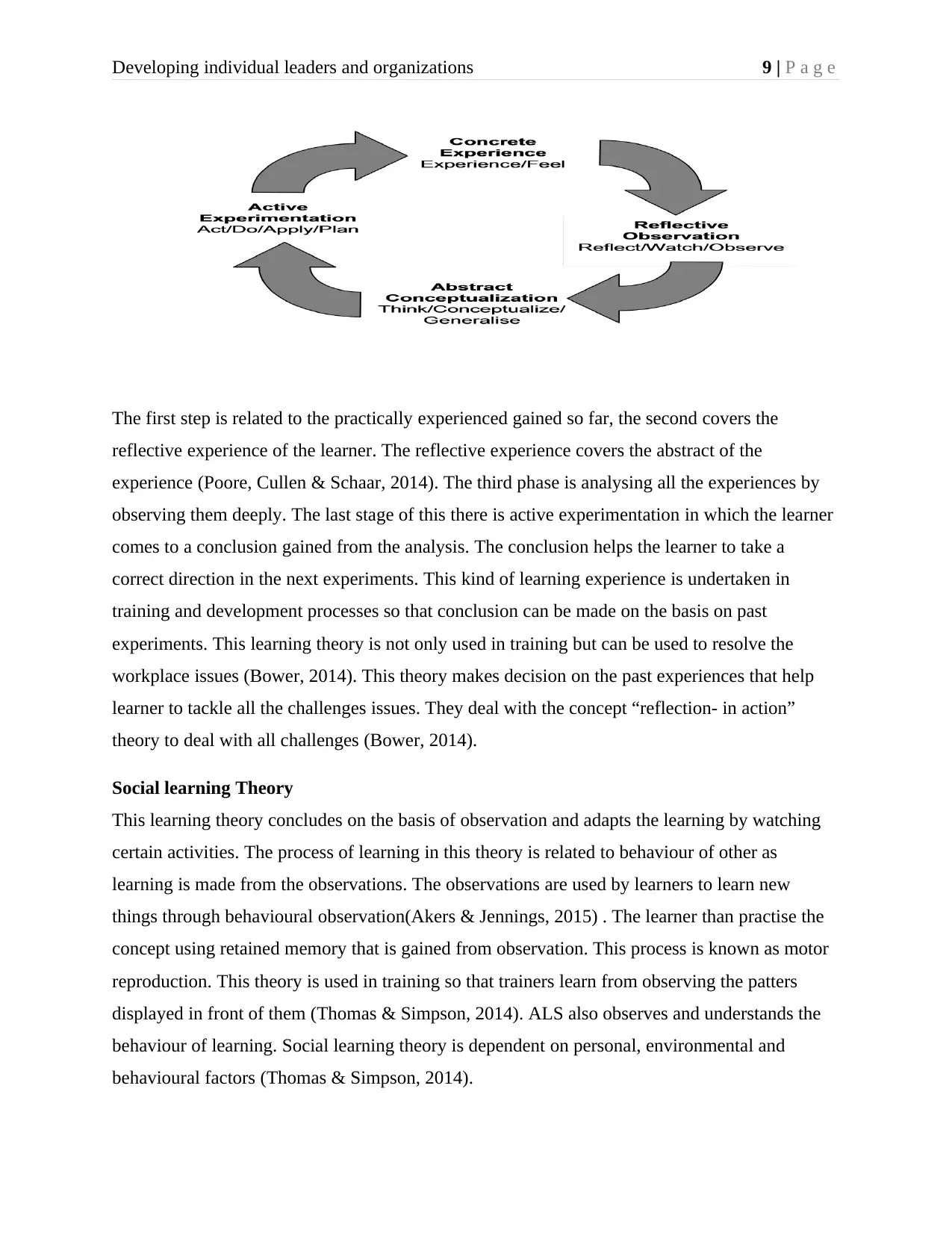
Developing individual leaders and organizations 9 | P a g e
The first step is related to the practically experienced gained so far, the second covers the
reflective experience of the learner. The reflective experience covers the abstract of the
experience (Poore, Cullen & Schaar, 2014). The third phase is analysing all the experiences by
observing them deeply. The last stage of this there is active experimentation in which the learner
comes to a conclusion gained from the analysis. The conclusion helps the learner to take a
correct direction in the next experiments. This kind of learning experience is undertaken in
training and development processes so that conclusion can be made on the basis on past
experiments. This learning theory is not only used in training but can be used to resolve the
workplace issues (Bower, 2014). This theory makes decision on the past experiences that help
learner to tackle all the challenges issues. They deal with the concept “reflection- in action”
theory to deal with all challenges (Bower, 2014).
Social learning Theory
This learning theory concludes on the basis of observation and adapts the learning by watching
certain activities. The process of learning in this theory is related to behaviour of other as
learning is made from the observations. The observations are used by learners to learn new
things through behavioural observation(Akers & Jennings, 2015) . The learner than practise the
concept using retained memory that is gained from observation. This process is known as motor
reproduction. This theory is used in training so that trainers learn from observing the patters
displayed in front of them (Thomas & Simpson, 2014). ALS also observes and understands the
behaviour of learning. Social learning theory is dependent on personal, environmental and
behavioural factors (Thomas & Simpson, 2014).
The first step is related to the practically experienced gained so far, the second covers the
reflective experience of the learner. The reflective experience covers the abstract of the
experience (Poore, Cullen & Schaar, 2014). The third phase is analysing all the experiences by
observing them deeply. The last stage of this there is active experimentation in which the learner
comes to a conclusion gained from the analysis. The conclusion helps the learner to take a
correct direction in the next experiments. This kind of learning experience is undertaken in
training and development processes so that conclusion can be made on the basis on past
experiments. This learning theory is not only used in training but can be used to resolve the
workplace issues (Bower, 2014). This theory makes decision on the past experiences that help
learner to tackle all the challenges issues. They deal with the concept “reflection- in action”
theory to deal with all challenges (Bower, 2014).
Social learning Theory
This learning theory concludes on the basis of observation and adapts the learning by watching
certain activities. The process of learning in this theory is related to behaviour of other as
learning is made from the observations. The observations are used by learners to learn new
things through behavioural observation(Akers & Jennings, 2015) . The learner than practise the
concept using retained memory that is gained from observation. This process is known as motor
reproduction. This theory is used in training so that trainers learn from observing the patters
displayed in front of them (Thomas & Simpson, 2014). ALS also observes and understands the
behaviour of learning. Social learning theory is dependent on personal, environmental and
behavioural factors (Thomas & Simpson, 2014).
⊘ This is a preview!⊘
Do you want full access?
Subscribe today to unlock all pages.

Trusted by 1+ million students worldwide
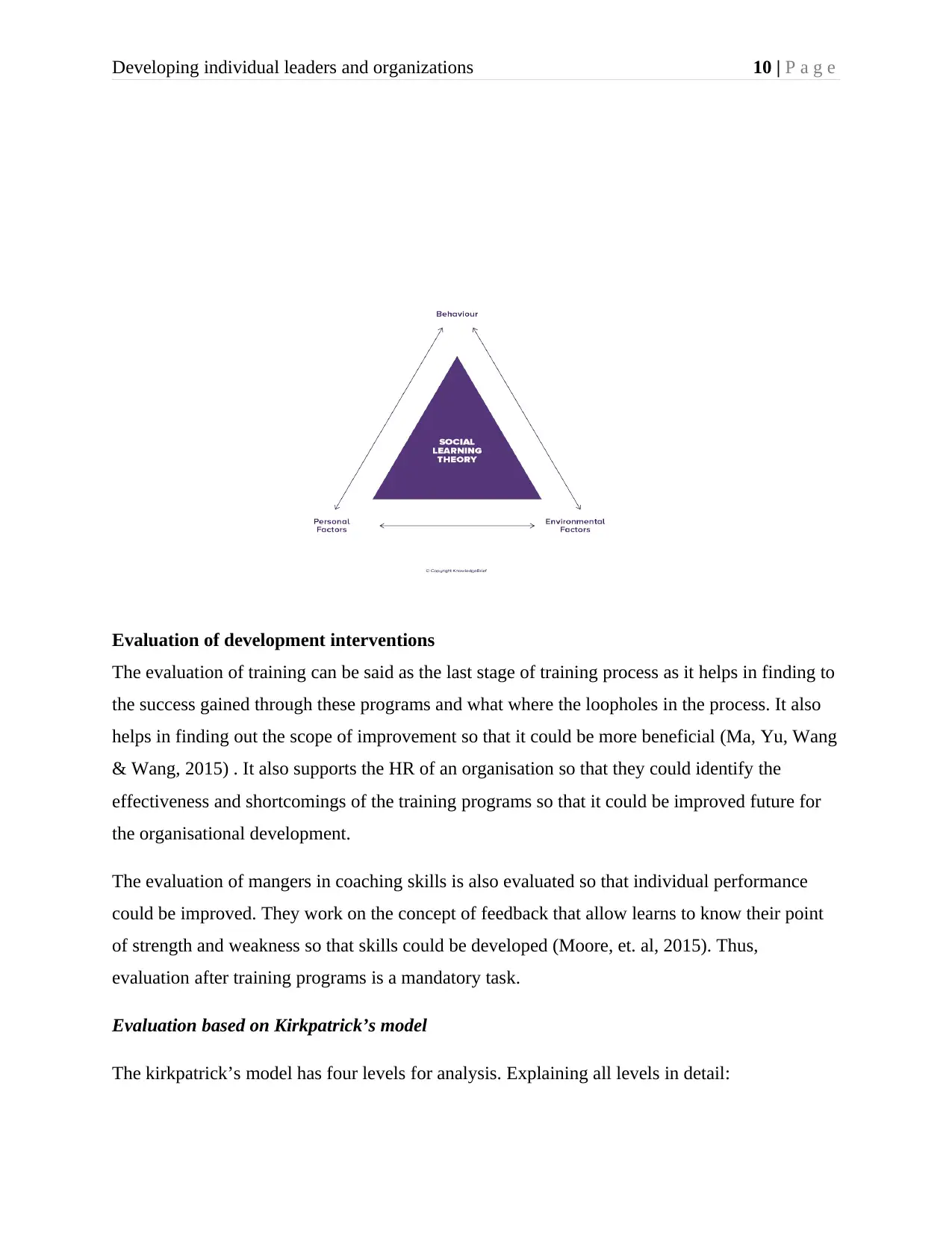
Developing individual leaders and organizations 10 | P a g e
Evaluation of development interventions
The evaluation of training can be said as the last stage of training process as it helps in finding to
the success gained through these programs and what where the loopholes in the process. It also
helps in finding out the scope of improvement so that it could be more beneficial (Ma, Yu, Wang
& Wang, 2015) . It also supports the HR of an organisation so that they could identify the
effectiveness and shortcomings of the training programs so that it could be improved future for
the organisational development.
The evaluation of mangers in coaching skills is also evaluated so that individual performance
could be improved. They work on the concept of feedback that allow learns to know their point
of strength and weakness so that skills could be developed (Moore, et. al, 2015). Thus,
evaluation after training programs is a mandatory task.
Evaluation based on Kirkpatrick’s model
The kirkpatrick’s model has four levels for analysis. Explaining all levels in detail:
Evaluation of development interventions
The evaluation of training can be said as the last stage of training process as it helps in finding to
the success gained through these programs and what where the loopholes in the process. It also
helps in finding out the scope of improvement so that it could be more beneficial (Ma, Yu, Wang
& Wang, 2015) . It also supports the HR of an organisation so that they could identify the
effectiveness and shortcomings of the training programs so that it could be improved future for
the organisational development.
The evaluation of mangers in coaching skills is also evaluated so that individual performance
could be improved. They work on the concept of feedback that allow learns to know their point
of strength and weakness so that skills could be developed (Moore, et. al, 2015). Thus,
evaluation after training programs is a mandatory task.
Evaluation based on Kirkpatrick’s model
The kirkpatrick’s model has four levels for analysis. Explaining all levels in detail:
Paraphrase This Document
Need a fresh take? Get an instant paraphrase of this document with our AI Paraphraser
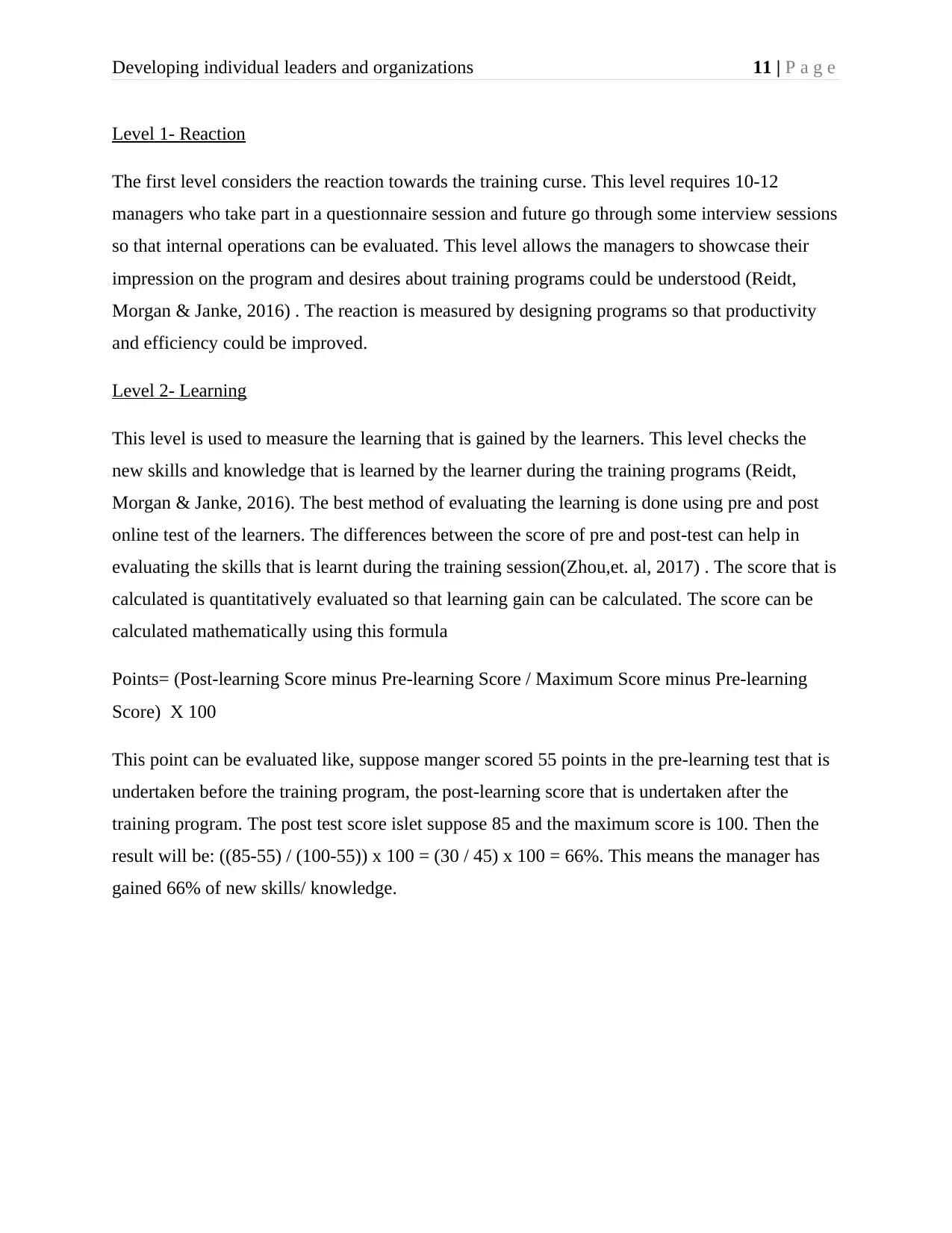
Developing individual leaders and organizations 11 | P a g e
Level 1- Reaction
The first level considers the reaction towards the training curse. This level requires 10-12
managers who take part in a questionnaire session and future go through some interview sessions
so that internal operations can be evaluated. This level allows the managers to showcase their
impression on the program and desires about training programs could be understood (Reidt,
Morgan & Janke, 2016) . The reaction is measured by designing programs so that productivity
and efficiency could be improved.
Level 2- Learning
This level is used to measure the learning that is gained by the learners. This level checks the
new skills and knowledge that is learned by the learner during the training programs (Reidt,
Morgan & Janke, 2016). The best method of evaluating the learning is done using pre and post
online test of the learners. The differences between the score of pre and post-test can help in
evaluating the skills that is learnt during the training session(Zhou,et. al, 2017) . The score that is
calculated is quantitatively evaluated so that learning gain can be calculated. The score can be
calculated mathematically using this formula
Points= (Post-learning Score minus Pre-learning Score / Maximum Score minus Pre-learning
Score) X 100
This point can be evaluated like, suppose manger scored 55 points in the pre-learning test that is
undertaken before the training program, the post-learning score that is undertaken after the
training program. The post test score islet suppose 85 and the maximum score is 100. Then the
result will be: ((85-55) / (100-55)) x 100 = (30 / 45) x 100 = 66%. This means the manager has
gained 66% of new skills/ knowledge.
Level 1- Reaction
The first level considers the reaction towards the training curse. This level requires 10-12
managers who take part in a questionnaire session and future go through some interview sessions
so that internal operations can be evaluated. This level allows the managers to showcase their
impression on the program and desires about training programs could be understood (Reidt,
Morgan & Janke, 2016) . The reaction is measured by designing programs so that productivity
and efficiency could be improved.
Level 2- Learning
This level is used to measure the learning that is gained by the learners. This level checks the
new skills and knowledge that is learned by the learner during the training programs (Reidt,
Morgan & Janke, 2016). The best method of evaluating the learning is done using pre and post
online test of the learners. The differences between the score of pre and post-test can help in
evaluating the skills that is learnt during the training session(Zhou,et. al, 2017) . The score that is
calculated is quantitatively evaluated so that learning gain can be calculated. The score can be
calculated mathematically using this formula
Points= (Post-learning Score minus Pre-learning Score / Maximum Score minus Pre-learning
Score) X 100
This point can be evaluated like, suppose manger scored 55 points in the pre-learning test that is
undertaken before the training program, the post-learning score that is undertaken after the
training program. The post test score islet suppose 85 and the maximum score is 100. Then the
result will be: ((85-55) / (100-55)) x 100 = (30 / 45) x 100 = 66%. This means the manager has
gained 66% of new skills/ knowledge.
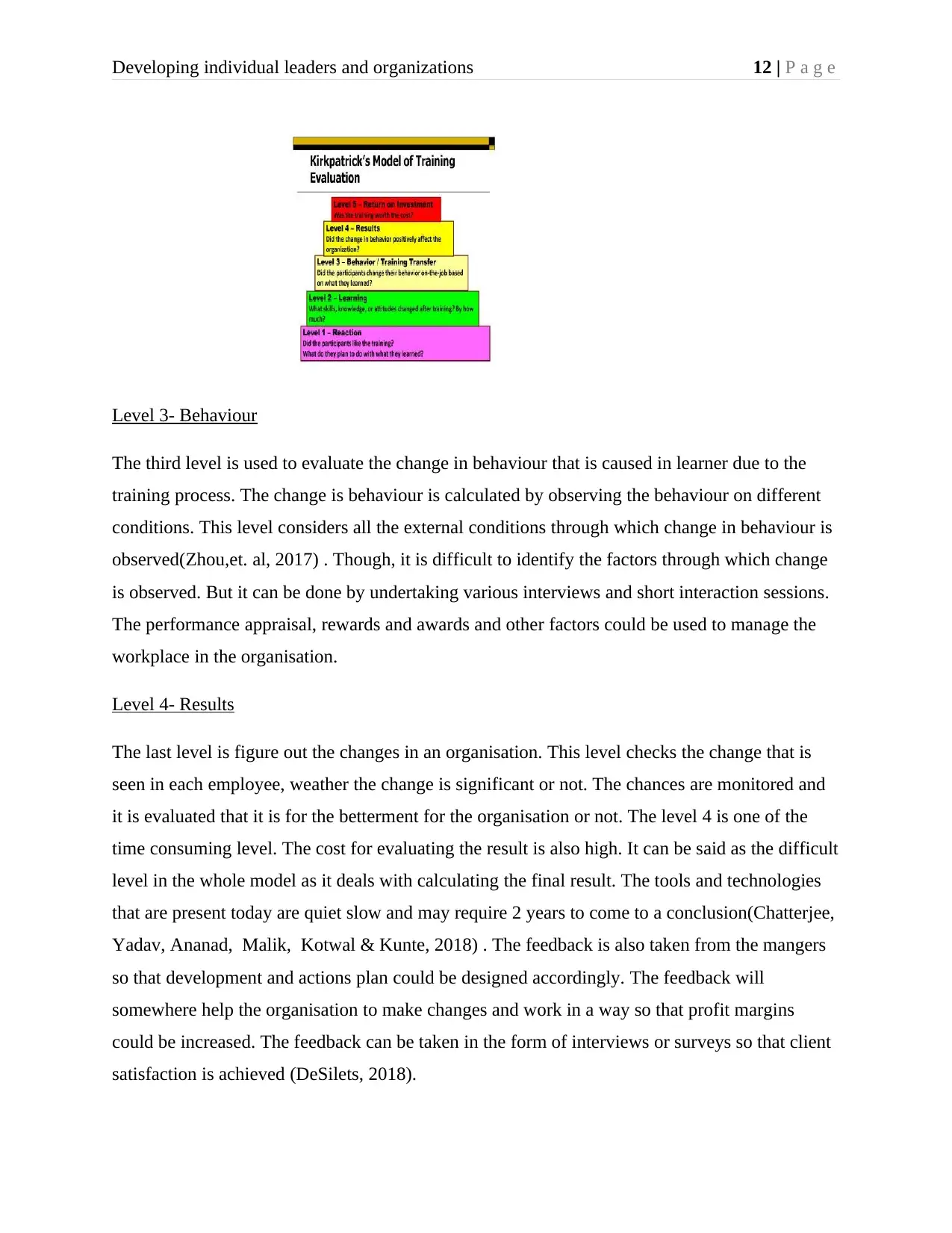
Developing individual leaders and organizations 12 | P a g e
Level 3- Behaviour
The third level is used to evaluate the change in behaviour that is caused in learner due to the
training process. The change is behaviour is calculated by observing the behaviour on different
conditions. This level considers all the external conditions through which change in behaviour is
observed(Zhou,et. al, 2017) . Though, it is difficult to identify the factors through which change
is observed. But it can be done by undertaking various interviews and short interaction sessions.
The performance appraisal, rewards and awards and other factors could be used to manage the
workplace in the organisation.
Level 4- Results
The last level is figure out the changes in an organisation. This level checks the change that is
seen in each employee, weather the change is significant or not. The chances are monitored and
it is evaluated that it is for the betterment for the organisation or not. The level 4 is one of the
time consuming level. The cost for evaluating the result is also high. It can be said as the difficult
level in the whole model as it deals with calculating the final result. The tools and technologies
that are present today are quiet slow and may require 2 years to come to a conclusion(Chatterjee,
Yadav, Ananad, Malik, Kotwal & Kunte, 2018) . The feedback is also taken from the mangers
so that development and actions plan could be designed accordingly. The feedback will
somewhere help the organisation to make changes and work in a way so that profit margins
could be increased. The feedback can be taken in the form of interviews or surveys so that client
satisfaction is achieved (DeSilets, 2018).
Level 3- Behaviour
The third level is used to evaluate the change in behaviour that is caused in learner due to the
training process. The change is behaviour is calculated by observing the behaviour on different
conditions. This level considers all the external conditions through which change in behaviour is
observed(Zhou,et. al, 2017) . Though, it is difficult to identify the factors through which change
is observed. But it can be done by undertaking various interviews and short interaction sessions.
The performance appraisal, rewards and awards and other factors could be used to manage the
workplace in the organisation.
Level 4- Results
The last level is figure out the changes in an organisation. This level checks the change that is
seen in each employee, weather the change is significant or not. The chances are monitored and
it is evaluated that it is for the betterment for the organisation or not. The level 4 is one of the
time consuming level. The cost for evaluating the result is also high. It can be said as the difficult
level in the whole model as it deals with calculating the final result. The tools and technologies
that are present today are quiet slow and may require 2 years to come to a conclusion(Chatterjee,
Yadav, Ananad, Malik, Kotwal & Kunte, 2018) . The feedback is also taken from the mangers
so that development and actions plan could be designed accordingly. The feedback will
somewhere help the organisation to make changes and work in a way so that profit margins
could be increased. The feedback can be taken in the form of interviews or surveys so that client
satisfaction is achieved (DeSilets, 2018).
⊘ This is a preview!⊘
Do you want full access?
Subscribe today to unlock all pages.

Trusted by 1+ million students worldwide
1 out of 21
Related Documents
Your All-in-One AI-Powered Toolkit for Academic Success.
+13062052269
info@desklib.com
Available 24*7 on WhatsApp / Email
![[object Object]](/_next/static/media/star-bottom.7253800d.svg)
Unlock your academic potential
Copyright © 2020–2025 A2Z Services. All Rights Reserved. Developed and managed by ZUCOL.





